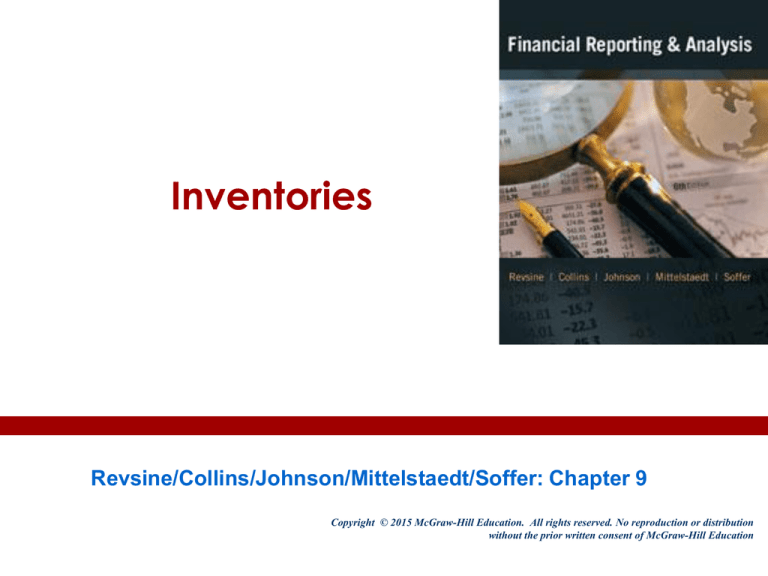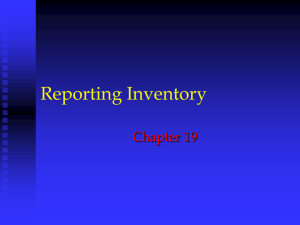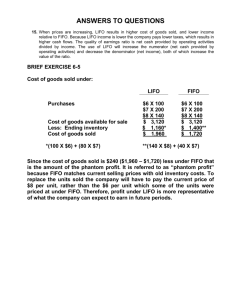
Inventories
Revsine/Collins/Johnson/Mittelstaedt/Soffer: Chapter 9
Copyright © 2015 McGraw-Hill Education. All rights reserved. No reproduction or distribution
without the prior written consent of McGraw-Hill Education
Learning objectives
1. The relationship between inventory valuation and cost of goods sold.
2. The two methods used to determine inventory quantities—perpetual
and periodic.
3. What types of costs are included in inventory.
4. What absorption costing is and how it complicates financial analysis.
5. The difference between inventory cost flow assumptions—weighted
average, FIFO and LIFO.
6. How LIFO reserve disclosures can be used to estimate inventory
holding gains and to transform LIFO firms to a FIFO basis.
9-2
Learning objectives concluded
7. How LIFO liquidation distorts cost of goods sold.
8. How LIFO affects firms’ income taxes.
9. Economic incentives guiding the choice of inventory methods.
10. How to apply the lower of cost or market method.
11. The key differences between GAAP and IFRS requirements for
inventory accounting.
12. How to eliminate realized holding gains from FIFO income.
13. How and why the dollar-value LIFO method is applied.
9-3
Inventory types
Wholesaler or retailer:
Manufacturer:
Supplier
Manufacturer
Firm
Raw materials
Firm
Merchandise
inventory
Work-in-process
Includes other
manufacturing
costs
Finished goods
Customer
Customer
9-4
Overview of accounting issues
Old unit
New unit
Issue: What costs are
included in inventory?
Issue: How is the cost of
goods available for
sale split between the
balance sheet and the
income statement?
9-5
Overview of accounting issues:
Summary
Three methods for allocating the
cost of goods available for sale:
Weighted average
FIFO
LIFO
GAAP does not require the cost
flow assumption to correspond to
the actual physical flow of
inventory.
If the cost of inventory never
changes, all three cost flow
assumptions would yield the same
financial statement result.
No matter what assumption is
used, the total dollar amount
assigned to the balance sheet and
the income statement is the same
($640 in this example).
9-6
Overview of accounting issues:
Allocating the cost of goods available for sale
Weighted average approach:
Uses the
the average
average cost
cost of
of the
the two
two
Uses
units.
units.
FIFO
produces
a smaller
expense
First-in, first-out (FIFO) approach:
Oldest unit cost flows to income.
Last-in, last-out (LIFO) approach:
LIFO
produces
a larger
expense
Newest unit cost flows to income.
9-7
Overview of accounting issues:
Unanswered questions
How should physical quantities in inventory be determined?
What items should be included in ending inventory?
What costs should be included in inventory purchases (and
eventually in ending inventory)?
What cost flow assumption should be used for allocating goods
available for sale between cost of goods sold and ending
inventory?
9-8
Determining inventory quantities:
Perpetual inventory system
This approach keeps a running (or “perpetual”) record of the
amount of inventory on hand.
The inventory T-account under a perpetual inventory system
looks like this:
Entries are made as
units are purchased
Entries are made as
units are sold
9-9
Determining inventory quantities:
Periodic inventory system
This approach does not keep a running (or “perpetual”) record of
the amount of inventory on hand.
Entries are made as units are purchased
Ending inventory and cost of goods sold must be determined by
physically counting the goods on hand at the end of the period.
9-10
Determining inventory quantities:
Periodic and perpetual compared
9-11
Determining inventory quantities:
Periodic and perpetual compared
Periodic inventory
Perpetual inventory
Less recordkeeping means lower
cost to maintain.
More complicated and usually more
expensive.
Less management control over
inventory.
Does not eliminate the need to take
a physical inventory.
COGS is a “plug” figure and there is
no way to determine the extent of
inventory losses (“shrinkage”).
Better management control over
inventories including “stock outs”.
Typically used for low volume, high
unit cost items (e.g., automobiles)
or when continuous monitoring of
inventory levels is essential.
Typically used when inventory
volumes are high and per-unit costs
are low.
9-12
Items included in inventory
In day-to-day operations, most firms record inventory when they
physically receive it.
However, when it comes to preparing financial statements, the
firm must determine whether all inventory items are legally owned.
Goods in transit may be “owned” by the buyer or the seller.
The party that has legal title during transit will record the items as
inventory.
Consignment goods should not be counted as inventory for the
consignee.
Consignor
Owner
consigned
goods
Consignee
Sale
Customer
Agent
9-13
Costs included in inventory
All costs required to obtain physical possession of the inventory
and to make it saleable.
Purchase cost
Sales taxes and transportation paid by the buyer
Insurance costs
Storage costs
Production costs (labor and overhead) for a manufacturer
In theory, inventory costs should also include the (indirect) costs
of the purchasing department and other general and
administrative costs associated with the acquisition and
distribution of inventory.
However, most firms exclude these items and limit inventory costs
to direct acquisition and processing costs.
9-14
Costs included in inventory:
Manufacturing costs
9-15
Costs included in inventory:
Absorption costing versus variable costing
Fixed
production
costs
Manufacturing rentals
and depreciation
Property taxes
Variable
production
costs
Variable
production
costs
Raw materials
Direct labor
Variable overhead, like
electricity
Variable costing of
inventory (not
allowed by GAAP)
Absorption costing
of inventory
(required by GAAP)
9-16
Costs included in inventory:
Summary
This approach is not
allowed by GAAP.
These are never
included in inventory.
9-17
Costs included in inventory:
How absorption costing can distort profitability
As we shall see, the GAAP gross margin increases from $110,000 in
2014 to $130,000 in 2015 even though variable production costs and
selling price are constant, and sales revenue has fallen.
9-18
Costs included in inventory:
Absorption costing distortion
9-19
Costs included in inventory:
Variable costing illustration
Under variable costing the gross margin falls
9-20
Cost flow assumptions:
The concepts
In a few industries, it is possible to identify which particular units
have been sold. Examples include jewelry stores and automobile
dealerships. These firms use specific identification inventory
costing.
For most firms, however, a cost flow assumption is required.
9-21
Cost flow assumptions:
First-in, First-out (FIFO) illustrated
FIFO
9-22
Cost flow assumptions:
First-in, First-out (FIFO) illustrated
Figure 9.1 FIFO Cost Flow
9-23
Cost flow assumptions:
Last-in, First-out (LIFO) illustrated
LIFO
9-24
Cost flow assumptions:
Last-in, First-out (LIFO) illustrated
Figure 9.2 LIFO Cost Flow
9-25
Cost flow assumptions:
Inventory holding gains summary
Figure 9.3
Holding gain
flows to income
Holding gain still
on balance sheet
9-26
Cost flow assumptions:
LIFO and inventory holding gains
Holding gain remains
on balance sheet
Usually (but not always) the same; however balance sheets
are very different.
9-27
Cost flow assumptions:
FIFO and inventory holding gains
FIFO automatically includes the holding gain on units that are sold.
9-28
Cost flow assumptions:
The LIFO reserve disclosure
Amount
shown on
balance sheet
if FIFO had
been used
Amount
actually
shown on
balance sheet
9-29
LIFO and inflation:
LIFO reserve
Figure 9.4 Magnitude of
Inventory and LIFO Reserve
relative to CPI and Oil Prices
9-30
LIFO liquidation
When a LIFO firm liquidates old LIFO layers, the net income
number under LIFO can be seriously distorted.
Current
purchases
45 units at $600 each
3rd layer
30 units at $500 each
2rd layer
20 units at $400 each
1st layer
10 units at $300 each
45 units at $600 each
80 units
30 units at $500 each
were sold
5 units at $400 each
How old
LIFO cost
distorts
COGS
LIFO cost of goods sold
Goods available
Old LIFO layers that are liquidated are “matched” against sales
dollars that are stated at higher current prices.
9-31
LIFO liquidation disclosures
Income tax effect ($910,000) was the difference.
9-32
Tax implications of LIFO
U.S. tax rules specify that
if LIFO is used for tax
purposes, LIFO must also
be used in external
financial statements.
This LIFO conformity rule
explains why so many
firms use LIFO for financial
reporting purposes.
9-33
Eliminating realized holding gains
for FIFO firms
Reported income for FIFO firms always includes some realized
holding gains during periods of rising inventory costs.
The size of the FIFO realized holding gain depends on:
How fast input costs are changing.
How fast inventory turns over during the period.
x 10% cost increase
Replacement COGS = 7,900,000
= 8,000,000
+
100,000
Realized FIFO
holding gain
9-34
Reasons why some companies do
not use LIFO
The estimated tax savings is too small.
Business cycles may cause extreme fluctuations in physical
inventory levels.
The rate of inventory obsolescence is high.
Managers may want to avoid reporting lower profits because they
believe doing so will lead to:
Lower stock price
Lower compensation from earnings-based bonuses
Loan covenant violations
Small firms may not find LIFO economical because of high recordkeeping costs.
9-35
Lower of Cost or Market Method
If the market value of inventory falls below its cost, the carrying value
must be reduced. Market value is subject to two constraints:
Ceiling – Net Realizable Value
Floor – Net Realizable Value less normal profit margin
Figure 9.5
Ceiling
Floor
9-36
Lower of Cost or Market Method
The journal entry when inventory with a cost of $1,000,000 is
written down to a market value of $970,000 would be (assuming
the use of the perpetual inventory method):
The lower of cost or market method can be applied to:
• Individual inventory items
• Classes of inventory
• The inventory as a whole
9-37
Global Vantage Point
Comparison of IFRS and GAAP Inventory
Accounting
IFRS guidelines for inventory are similar to U.S. GAAP
Two important differences
LIFO is not permitted under IAS 2
Lower of cost or market is applied differently. Market is net realisable
value (no ceiling or floor). IAS 2 allows inventory reductions to be
reversed if the market recovers, but the inventory carrying amount
cannot exceed the original cost.
Something to consider: LIFO conformity rule. Firms would incur
large tax liabilities if they eventually move to IFRS which does not
allow LIFO.
9-38
Summary
Absorption costing is required by GAAP but can lead to potentially
misleading trend comparisons.
GAAP allows firms latitude in selecting a cost flow assumption.
Some firms use FIFO, others use LIFO, and still others use
weighted-average.
This diversity can hinder comparisons across firms, thus it’s often
useful to convert LIFO firms to a FIFO basis.
Reported FIFO income includes potentially unsustainable realized
holding gains.
Similarly, LIFO liquidations distort reported margins.
Old, out-of-date LIFO layers can distort various ratio comparisons.
9-39
Summary concluded
Users must understand these inventory accounting differences
and know how to adjust for them. Only then can valid
comparisons be made across firms and over time.
To address inventory obsolescence, GAAP requires inventory to
be carried at lower of cost or market (LCM).
IFRS accounting for inventory is very similar to GAAP, but LIFO is
not allowed.
The LIFO conformity rules requires firms to use LIFO for financial
reporting if they use it for tax reporting.
Most LIFO firms use some form of dollar-value LIFO.
9-40



